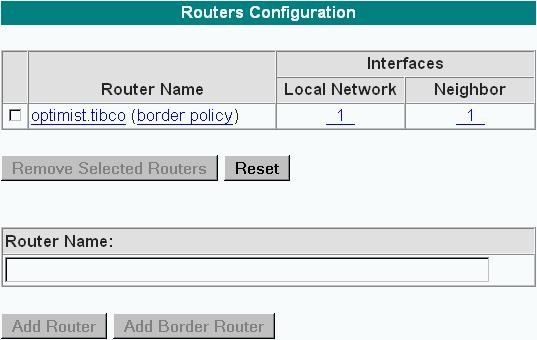Routers
This page lets you configure routing table entries (router names). For more information, see Routing Table Entry.
To display this page, click Routers in the left margin of any page of the rvrd browser administration interface.
Identify each routing table entry by a globally unique name.
You can add a new entry or remove an existing entry at any time. (However, border routing introduces restrictions; see Border Routing.)
For background information, see Routing Table Entry, and Independent Routing Table Entries in One Process.
Figure 100: rvrd Routers Configuration Page
|
Item |
Description |
|
Existing Routers |
This panel lists the routing table entries within this routing daemon process. Each row represents one routing table entry. |
|
Router Name |
This column displays the router name of a routing table entry. Click here to set the maximum backlog for the routing table entry; see Backlog Protection. When configured as a border router, the phrase (border policy) appears after the router name. To configure or view the border policy, click this phrase; see Border Policy. (For background information, see Policy.) |
|
Local Network |
The number of local networks configured for a routing table entry. Click here to view the page Local Network Interfaces Configuration. |
|
Neighbor |
The number of neighbors configured for a routing table entry. Click here to view the page Neighbor Interfaces. |
|
Add Router |
To add a first-tier router, type its name, then click this button. |
|
Add Border Router |
To add a border router, type its name, then click this button. See also, Border Routing, below. |
|
(border policy) |
To view the page Border Policy, click this phrase (border policy) following the name of a border router. |
